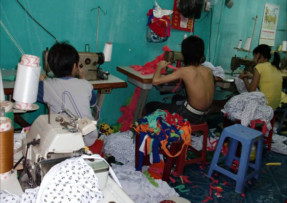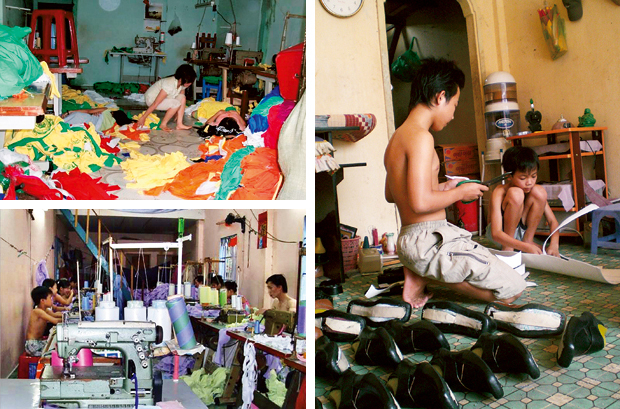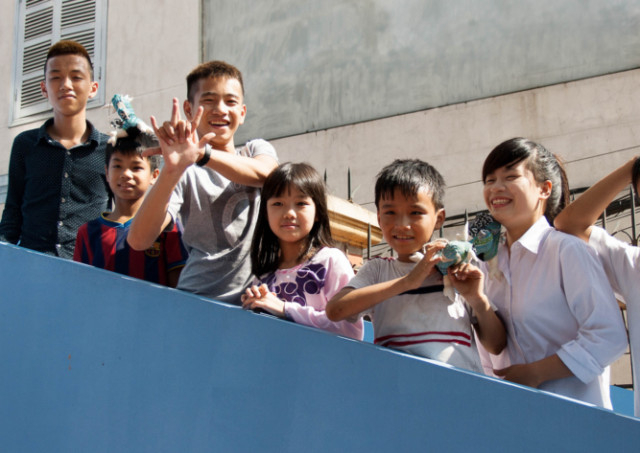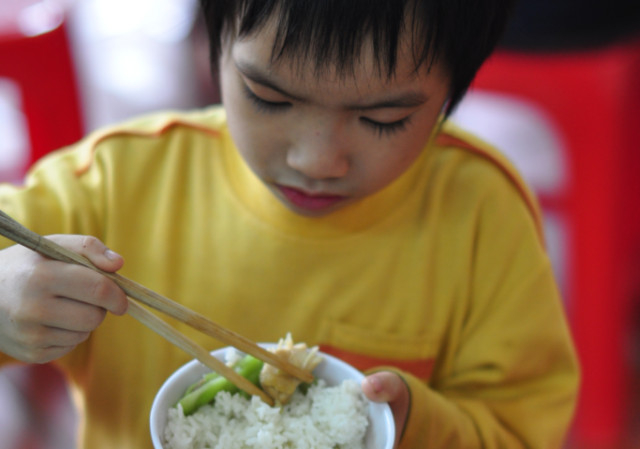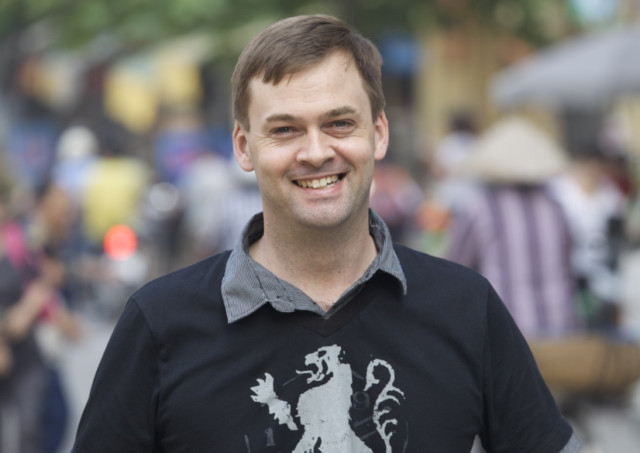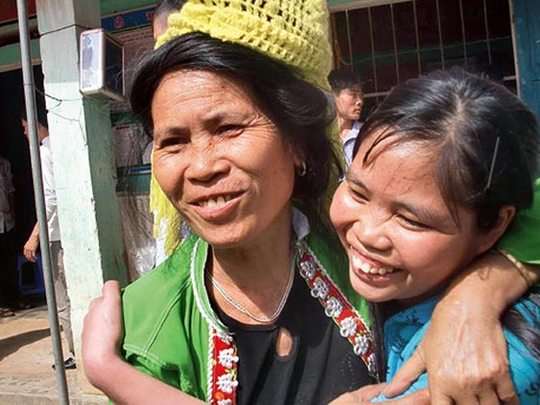
Thu’s childhood innocence was stolen in a gust of false promises and a web of words. Tempting tales of bright lights and big cities were used by human traffickers to cunningly captivate the shy teenager before plucking her from her familiar surroundings of Dien Bien province in Vietnam to take her to the vast and unfamiliar capital Ho Chi Minh City.
At just 15 years old, Thu’s* naivety had been exploited by thinly veiled lies of a promising future, a free vocational education and an opportunity to step out from the interminable cycle of her childhood poverty. Dreams destroyed, Thu would soon learn that the bright lights were in fact fluorescent factory neon strips; and the big city a squalid, 40-square metre sweatshop.
Here, alongside 12 other children, she would spend the following two years working 17-hour shifts, seven days a week. Beaten, refused daylight, sustained on a poor diet and forbidden to use the washroom for more than a total of eight minutes a day, Thu and the trafficked children are a sad part of the long list of Vietnam’s vanished.
Luckily for Thu, she was one of the fortunate girls to have been rescued by Blue Dragon during a raid on a sweatshop.
The Asian country’s rapid economic growth and popularity as a tourism destination is well known; its status as a hotbed for human trafficking however is not. In 2012, Vietnam was placed on a Tier 2 Watch List by the US Department of State’s Trafficking in Persons Report. It states that although the government is making efforts to eliminate trafficking, it is still not fully complying with the Trafficking Victims Protection Act’s minimum standards to identify and protect trafficked persons.
A clandestine and complex industry
The exact number of children trafficked domestically and internationally in Vietnam is unknown and as Michael Brosowski, founder of anti-trafficking charity Blue Dragon who rescued Thu, says, “If you can count them why can’t you rescue them?”
The clandestine and complex nature of the trafficking industry makes dependable figures or valid assessments near impossible, while official figures often do not accurately reflect the scale or demographics of the problem.
In their Programme 130 – Response to Trafficking, the Vietnamese Government estimated that approximately 6,000 women and children were trafficked between 2005 and 2009. However, human rights groups across the country believe this figure to be far higher. The Child Exploitation and Online Protection Centre in Hanoi (CEOP) in a 2011 report said approximately 40,000 women and children are recorded as missing or unaccounted for. But many charity workers think it is only the tip of the iceberg. Vietnamese women and children often fall prey to a trafficking industry that sees them moved within the country and across its borders for exploitation.
Children are targeted for their vulnerability and young girls remain an increasingly valuable commodity for the flesh trade. As Colonel Nguyen Van Tuat, head of Lai Chau Province’s Border Military Office, told VietNam News, “We discovered a case where a father had sold his one-year old... for $1,077 (Dh3,955). When he was caught, he said, ‘It was my daughter and I have the right to sell her if I want to.’”
Trafficking of children and adults from rural provinces to urban centres of Hanoi or Ho Chi Minh is commonplace. In cities, they become helpless hostages of an illicit tourism industry, family-run slave labour factories or street peddling traders. Children are at the mercy of violent captors, obligated to work the streets selling bric-a-brac to tourists from dusk until dawn under the watchful eyes of keepers.
Huy* was trafficked from the rural hinterlands to Ho Chi Minh at just 13. Stolen from his poor but loving family who lived in a tin shack, he was subjected to a brutal life of relentless hawking and forced to return every penny earned, or food donated, to his captors.
Suffering from malnutrition and exhaustion, Huy was rescued by volunteers from Blue Dragon who had spent days watching his movements through the tourist districts. Initially when he spoke his words were slurred, suggesting he was suffering from a speech impediment. It was only after he had food, rest and attention that the volunteers discovered the slurring was a result of sheer fatigue.
Huy was fortunate to have been spotted by Blue Dragon and despite the NGO’s notable attempts to rescue trafficked children across the country, there are continued international and domestic calls for a unified and improved victim identification and protection scheme.
As part of the government’s response to this mounting pressure, measures are slowly being put in place to match trafficking clampdowns of neighbouring countries. In January 2012, Vietnam’s Prime Minister approved the new five-year National Plan of Action on Human Trafficking and labour attachés are now present in nine countries hosting the largest number of Vietnamese migrant workers.
However more needs to be done to match efforts in surrounding countries such as Thailand where thousands of police, prosecutors, social workers, and border officials are receiving training on victim identification. Stricter laws in neighbouring countries coupled with less effective policing systems in Vietnam, have resulted in higher levels of people poaching from within its borders and a shift in destination for illegal tourist activities. As cited in the Vietnam Trafficking in Persons Report 2011 by the US Department of State, a study by an Australian NGO reported as many as 80 cases of commercial exploitation for tourists in the Sa Pa district alone working for visitors originating from countries including Japan, Taiwan, the UK, Australia and Europe.
The increase in demand for Vietnamese internally and transnationally means traffickers now resort to a multitude of means to lure the young and vulnerable. Residents of poor, rural or mountainous provinces are principle targets and false promises of job opportunities are used to lure ill-fated people away from home. Many are moved by land across borders into neighbouring Cambodia, China and Laos but recent media reports suggest trafficking rings extend far beyond Asia. Earlier this year the anti-trafficking advocacy group Coalition to Abolish Modern-day Slavery in Asia (Camsa) publicly exposed a trafficking ring in Moscow that they say just scratches the surface of the thousands of sweatshops and illicit businesses in the Russian capital.
In an interview with Radio Free Asia, Camsa co-founder Nguyen Dinh Thang said most of the trafficked young women are forced into slave labour on the back of employment offers. One rescued girl, Be Huong, added that she made the risky decision in pursuit of a better life and had been easily duped by the offer of a three-month stint in a Moscow restaurant.
These methods are used effortlessly and all too often residents agree to be smuggled abroad into lands of opportunity only to find themselves in an alien environment and at the mercy of traffickers. Far from home they are enslaved to debt bondage, working for a pittance year after year in an attempt to pay off extortionate interest rates on visa and transport fees.
Many of these workers are processed through private labour export companies who reportedly coerce migrants to sign contracts in foreign languages and charge illegal fees, sometimes as much as $10,000. Such actions have forced Vietnamese migrants to be recognised as incurring some of the highest debts among Asian expat workers, according to 2011 US Department of State Trafficking in Persons Report.
Prolific trade with China
Aside from slave labour many Vietnamese are trafficked for forced marriages and adoption, predominately to China, where a decade’s one-child policy and preference for sons has resulted in a scarcity of women. According to the Vietnamese Ministry of Labour, Invalid and Social Affairs (Molisa), around 20,000 women and children were trafficked from Vietnam to China over the ten-year period of 1990 to 2000 alone, while according to the NGO World Children, in the past five years, it is estimated approximately 5,000 more have been taken.
The reasons behind the prolific nature of this illicit trade within Vietnam are complex and extensive, and combating the phenomenon has become an increasingly important priority for governments around the world. Joint anti-trafficking agreements have been signed between Vietnam and Cambodia, Thailand and China to ensure the neighbours co-operate in identifying, protecting and offering safe return to victims while jointly investigating and prosecuting traffickers.
Domestically, steps are being taken to recognise the escalating issue and penalise those responsible. In 2010, a new clause was added to an existing law to criminalise trafficking within Vietnam’s boundaries however, the translation has been left gapingly open to interpretation. The term ‘trafficking’ in Vietnamese is ‘buon ban’, literally ‘buy and sell’ and consequently legal processes can be arduous and lengthy. Trafficking has now been recognised as an illegal activity with corresponding punishments. Labour trafficking carries a seven-year jail term, while child trafficking can result in a life sentence.
However the general consensus from those fighting on the ground is that the penalties are still often too light to compensate for the life-lasting effects of a trafficking nightmare.
Nonetheless, thanks to the unflagging dedication of anti-trafficking personnel both within the government and charities, much is being done to stamp out the trade in Vietnam. The work of tireless organisations such as Blue Dragon means communities are becoming gradually more aware of the problem and consequently traffickers are steadily beginning to disappear from target regions. However more is needed to unify these efforts both within governmental and non-governmental organisations if there is to be any hope of fully eradicating the problem nationwide.
Meanwhile, the Thus of Vietnam remain at risk of falling prey to the multi-billion dollar industry and as Trinh Thi Ly, Anti-Human Trafficking Manager at the Centre for Studies and Applied Sciences in Gender, Family, Women and Adolescents (CSAGA) points out in VietNam News, “A person can be made to work every day so the profits are high, even higher than drug smuggling.” Although the governmental agency Molisa is officially responsible for reintegrating trafficked persons back into society, much of the work across the country is carried out by NGOs. Together they raise awareness in remote areas, while shelters across the country accommodate, reintegrate, educate, support and care for victims.
Working tirelessly to stop trafficking
Since 2006, as part of their anti-trafficking programme, Blue Dragon has successfully rescued 278 trafficked children and dissolved at least four trafficking rings. With 40 members of staff, including their indispensable Vietnamese lawyer Ta Ngoc Van, the volunteers help rescue children from traffickers and return them, when possible and plausible, to their families.
Importantly they are also working tirelessly to prevent trafficking by creating educational programmes among villages, while providing counselling for the affected communities. Reintegration is pivotal and Blue Dragon works at all levels to ensure children are provided with aftercare, while guiding them back into education or training. In 2011, Michael Brosowski was listed as a CNN Hero, and in 2012 was made a member of the Order of Australia in recognition of his work across Vietnam.
Stories rescued children narrate are heart-rending: Binh was just 12 years old when he was bought in Vietnam’s Hue province. Traffickers paid his parents roughly $120 for their son; a hefty amount when compared to the family of five’s combined income of just $20 a month. Binh’s parents were assured that their son would work only a few hours every day while receiving a vocational education, a promise that swayed their decision to allow him to leave.
Binh was taken 600 miles away to Ho Chi Minh City where he was forced to sell roses on the streets and outside clubs from 4pm to 3am every night – a far cry from the “one or two hour working days” his traffickers had promised. Often forced to work with no sleep, surviving on meals of plain rice, Binh had to hand over every penny earned to his captors while being subjected to regular beatings for failing to bring back enough money.
However Binh was one of the lucky ones. Spotted by Blue Dragon’s Michael and consequently rescued by his team, Binh was 13 when he was returned north to Hanoi and enrolled in school for the very first time.
Binh was able to provide essential information on other children trapped in slave labour factories across Ho Chi Minh City and consequently, not only were the other children rescued, but ultimately through a combined effort between Blue Dragon and local authorities, the ring was brought down.
That rescue resulted in the inauguration of Safe and Sound, a scheme that was realised to rescue children, return them to their families, continue to support them through rehabilitation and raise awareness across communities about the dangers facing the young in rural provinces.
Blue Dragon has now been rescuing trafficked children like Binh since 2006 and won’t stop until trafficking has been stopped.
Blue Dragon’s achievements
- Sent 2,629 children back to school and training
- Provided accommodation for 142 girls and boys
- Built or repaired 59 homes for families
- Reunited 129 children with their families
- Served 313,037 meals
- Distributed 35,507 litres of milk
- Handed out 39,584 kilos of rice
- Taken 1,066 children to a doctor or hospital
- Put six teens through drug rehab
- Placed 120 teens in jobs
*names changed to protect identity


